Artists have career, or even mid-career, retrospectives; galleries, less frequently. Many galleries don’t last as long as a successful artist’s career; fewer still have something that needs to be said or demonstrated about their having arrived at two or three or more decades. The Alice F. and Harris K. Weston Gallery, having successfully shown work worth seeing for twenty years, is like the best man who now stands up at the wedding, starts the clinking of glasses, and waits for the noise to settle down so he can speak. What will he say?
I am agnostic about whether a gallery of contemporary visual art truly complements the evening theater activities that have come to define the Aronoff Center. It would be an interesting sociological experiment—or perhaps more fittingly, an absorbing performance piece—to document the Broadway Series audiences’ responses to the Weston’s shows. How many venture into its fine and rather sleek (if also somewhat conventional) space downstairs during intermissions? (The upstairs space is more open and brighter, capable of displaying larger-scaled pieces, and more intrinsically capable of surprising.) The Weston, as far as I can tell, has not tailored its shows to the Aronoff’s clientele. It is fair to say that over the years, it has shown a large selection of interesting, important, and challenging artists from Greater Cincinnati and beyond. Between one-person and group shows, the Weston has shown some 900 artists, about 150 of which have been the subject of solo exhibitions. This cannot have made it easy for the gallery’s second Director, Dennis Harrington, to curate.
Or, really, for most people to visit and digest. Viewers are pretty much on their own. There are no explanatory curator’s panels on the wall or bulging notebooks on desks with artist’s statements. In that regard, the gallery is confident that it can show work that will seem meaningful and coherent together without context and that understanding either the artist’s or the curator’s intentions aren’t vital. It’s often not entirely clear whether the works of art are intended to address the time when their creators showed at the Weston, or whether they are completely fresh works. It is difficult to contextualize the show. (Is it an alumni exhibition?) A lot can happen in twenty years, though the show does not deliberately try to call attention to any of the ways that either artists or issues, both social and aesthetic, have developed over the course of two decades. But it turns out that this anthology show has been curated by Dennis Harrington with insight and imagination and has been hung so as to suggest thoughtful and thought-provoking connections between and among the works. It is hardly a thesis show, but it offers us a chance to experience a selection of some of the kinds of things artists are thinking about, and some of the rich and varied ways a serious gallery captures them doing so.
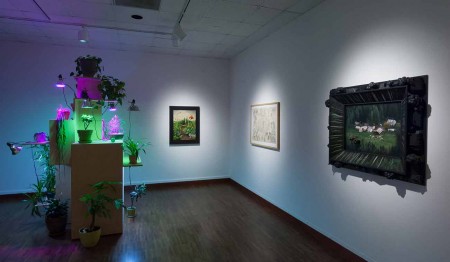
A place to start might be Todd Slaughter’s part-photograph, part-sculpture “Aryan Nation Headquarters” (2016). The color print, surrounded by a sculptural frame, shows what might be a drone’s-eye view of an unprepossessing group of buildings, one of which seems to be a church, in a cleared field at the edge of some woods. If it’s the Aryan Nation Headquarters, it’s only because the work’s title says so; there are no offensive flags or squads of goons, and we know how illusory photographic documentation can be. There are various markings of socio-economic class, including a lot of pickup trucks. It could all just as easily be some Christian day camp—and perhaps it is. The banality of evil, and all that.
Slaughter wants to highlight how ordinary it all is. The frame is surrounded by a border of computer-fabricated suburban houses and trees, all painted black (and there are even some green, glowing tiny dogs in some of the yards). So does the frame itself serve as a sort of wall designed to separate the suburban idyll from the looming evil suggested by the photo and the title? Is it intended to suggest that the people in the suburban houses block themselves off from the evil in their midst? Who knows what is hidden in those woods. Or are those the ordinary houses that the people who inhabit the Headquarters buildings go home to, where they continue to look just exactly like their neighbors?
The piece also asks us to consider our own position as we look from some considerable height down on the campsite. There is a hint of surveillance in the image, something that make us feel relieved (or excited) by not having to get too close. If you go out in the woods today, you’re going to have a big surprise. Sitting on the surface of the photo is one final sculptural element, a person playing on a seat or perhaps falling off it, poised vertiginously over it all, like Little Nemo’s dream becoming a nightmare. The figure is about to take Alice’s plunge into a Wonderland whose danger is hard to understand from the distant perspective. Does the figure stand for us? In this world, is it equally dangerous to be seen and to see?
Slaughter’s is among the most explicitly political of the works in the show, though Joseph Winterhalter’s “LVG 21c #30: More fun in the New World…” (2012) also raises some interesting cultural questions. Cool and abstract, it is composed of an assemblage of wall fragments, the flat, so-far-ungraffitied surfaces that help define and contain our culture. One section of the wall seems to be a wooden fence; one is a blank white-ish surface stained and pockmarked like an Aaron Siskind photograph; one portion is an artistic rendering of that perennial fashion favorite, the camo look (virtually infinitely accessorizable these days). It is useful to remember that hunter’s camouflage is, after all, a form of landscape art. The top segment is a pixilated band which invokes the world of computers to complete our tour of what interests our culture these days: privacy and property; decay and elegance; the machine-made and the hand-made; violence, survival, and consumer culture; and our conviction that our computer will lead us through all this and help us understand it.
Several artists bring nature into play throughout the show by calling attention to the ways in which we have colonized it and turned it into a vehicle for our story-telling, for better or worse. Nature is an essential element in our cultural self-portrait. Danielle Julian Norton’s “Talking to Plants” (2016), for example, is composed of a collection of live house plants sustained—indeed, over-stimulated—by grow lights in several different tints, all arranged fluidly on a set of multi-layered wooden shelves. On the whole, it seems designed to celebrate fecundity: specimens (far be it for me to identify just exactly what anything is) spill out of their containers and overflow their shelves like streams of lava, the Rapunzels of the plant world. The thriving plants raise issues of upstairs/downstairs: without the grow lights, in the windowless main space of the Weston, none of this excess would be possible. Though they are filled with life force, the plants represent nature that is tamed, transformed into something artificial, and forced to produce and over-produce, like the inhabitants of a dairy farm. When we collaborate with nature, we change it.
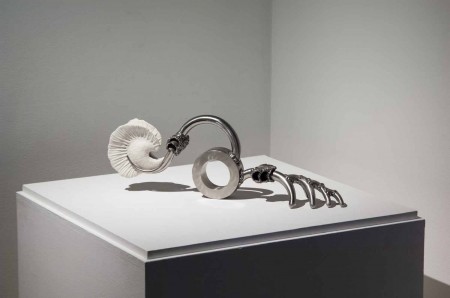
It’s certainly arguable that humans have taken their lead from nature and then forget where all those shaping ideas came from. Carmel Buckley’s “Untitled” pen drawing (2014) tries to bring the artificial and the natural back together in a meticulous sketch that could be a scientific cross-section of some remarkable plant—or part of an architectural schematic of some enormous building. TODT, a family collaborative that makes art together, plays with the outrageously artificial world of nature in painted plastic in “The Secret” (2015). In an homage to the late northern European baroque, a plastic cherub confronts a plastic skull on a painted plastic forest floor, advising it, with a finger over its lips, to keep its secret. As if it had any choice! It has the feel of the 3-D translation of a centuries-old woodcut of some ancient story of a spirit wandering through the woods only to come across a relic that can be turned into a moralizing moment: memento mori. But what then is the secret? It is hardly a secret (let alone one that can be kept) to contemplate mortality on the decaying forest floor—complicated by the fact that this plastic forest floor will never decay, and that the tradition of memento mori is anything but a secret; moralists over many centuries have seen great value in shouting it from rooftops. Part of the pleasure of this piece is the satisfaction we get from seeing nature copied so cleverly and attentively, like seeing a display case with glass flowers, whose rendezvous with time will take the form of gathering dust rather than going to seed. The strikingly artificial nature displayed in Ana England and Steven Finke’s “Hollyhock” (2015) was also powerful. Fabricated out of porcelain and stainless steel, it takes the form of calligraphic, looping curves. It yokes together the delicacy and sexual suggestiveness of the porcelain flower with a steel ring that could be the monstrous vertebra of some automaton leading to a set of claws that could come out of Alien. We make things of beauty in nature’s image and then have reason to fear them, a lesson at the core of Mary Shelley’s Frankenstein.
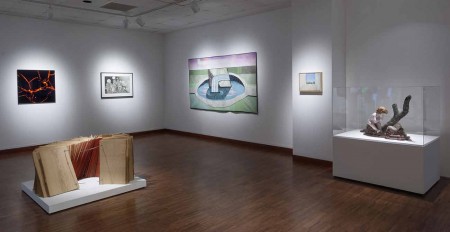
I was struck as well by Robert Fry’s “Tree Ring” (2014), a clever and allusive title, suggesting both the slow accretion of natural time and perhaps designed to make us think of a key ring, something we pocket and possess. “Tree Ring” is an almost circular collection of two foot high thin leaves of wood bound together by a pair of round metal rings. It looks like a giant rolodex turned on its side. It might be a collection of samples you could inspect at a home improvement center. But since the outer edges are not squared off, it also has the feel of the pages of a rather fine book with deckled edges. Trash and treasure.
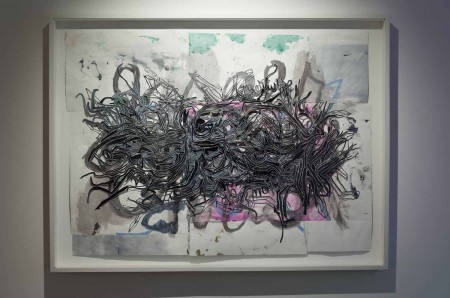
A central, time-honored move of modernity is to value the fragment. Many strands of contemporary art continue to build on that tradition, putting things together by a process of accretion. Mark Fox’s “Combs (Shipwreck)” (2014) is a piece created as if its component parts, the black lines, shapes, and words, have refused to adhere to the surface and have tangled themselves together in three dimensions. They have fallen off the page in a virtually unintelligible pile. The parts have become transformed into a new whole, made up of scraps and remnants, forsaking their origins and becoming a piece of low relief sculpture. Perhaps it is in part a diagram of what happens whenever we see a drawing or, even more broadly, what happens when we read anything. Mary Jo Bole’s “Family Tree of Life (Wounded Home Version)” (2013) is a drawing of a small blizzard of things: a squirrel (dancing? stuffed?), an elephant, bonnets, corsets, bullets of various lengths and diameters, limbs in buckets, sketches of organs, and a ring of architectural schematic drawings. There is a Drawing Room and a Withdrawing Room. At the center of it all is a tree, suggesting that we ought to look for ways in which the parts of this miscellany have some organic linkages.
In one corner is a commemoration of the house where Jennie Wade was killed on July 3, 1863. For those who did not bring their cell phones into the exhibition, Jennie Wade was the one civilian directly killed during the Battle of Gettysburg when a stray bullet entered her house, which is now a Pennsylvania tourist attraction. In some ways, perhaps the drawing tries to capture or at least suggest the vast randomness of 19th century culture—specifically, domestic culture as a 19th century woman might have encountered it–as it was forever frozen for Jennie Wade at the moment that she left it. It is hard not to think of Jennie Wade’s individual tragedy in the context of what warfare has become since 1863, where civilian carnage through “collateral damage” has come to far outnumber the losses suffered by actual combatants. The drawing includes a 19th century camera on a tripod which, instead of taking in the images of the world around it seems to be projecting something—perhaps this whole drawing?—onto the page, acknowledging how our understanding of history, and perhaps of art itself, is a combination of documentary impulses and fanciful ones.
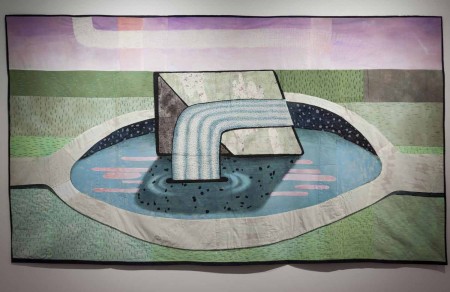
Denise Burge’s “Euphoric Recall” (2013) is a remarkable fabric piece that seemed to suggest a sort of monument in a reflecting pool one might encounter at a public sculpture garden. The title suggests that it is a kind of diagram about the workings of memory. A distant shimmer of rain passes across the sky and disappears into the horizon; meanwhile, apparently out of nowhere, a modest, rainbow-like torrent of a waterfall flows over a stone into the pool from which pathways lead. It is a thoughtful imagining of how we feel memory (one that Wordsworth would have understood and been comfortable with): we amplify something we have no current connection to, and fashion it into something of our own.
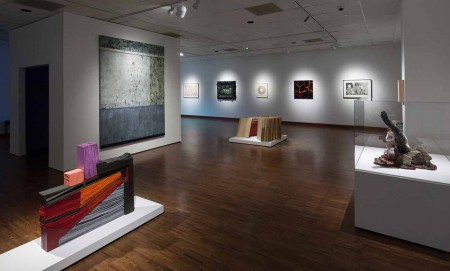
It was interesting how many pieces explored the boundaries between painting and sculpture, between the two-dimensional and the three-dimensional. Tracy Featherstone’s “Amy Sillman Translated” (2013) at first looks like a cross-section of a closet or a fanciful rendition of geological layerings with a fault line, like one might see in a campaign piece against fracking. But—again for those who did not bring their cell phones—Amy Sillman is a mid-career abstract painter who got her first major museum show at Boston’s Institute for Contemporary Art in 2013. I thought the piece worked well as any and all of the three possibilities, but in the context of the Mark Fox piece, it was especially interesting to see what might happen if a painting became a sculpture. How does a painting work if its lines had actual substance and mass and no longer could rely on the charm and energy of the autograph, spontaneous line? If lines were actually something an artist constructed? How might the different “sections” of a painting work if we envisioned them as actual, physical compartments? This is another way of saying that part of what made this piece exciting for me was to be able to see what a painting might look like through the eyes of a sculptor. Some of the painting’s lines were translated into a dark grey, but Featherstone’s piece came most alive where Sillman’s own colors took off, making it one of the least austere works in the show.
Least austere of all was the large three-piece installation by Jimi Jones, Ken Leslie, and Thomas Phelps who work together under the title of Neo-Ancestralists. Their “Neo-Ancestralist Combo” (2016) was also the least well-served by the reticence of artists and gallery to orient the viewer. Made up of three separate installations, the works were filled with objects repurposed in various ways and reassembled to suggest deliberately truncated, interrupted narratives. The Neo-Ancestralists are three African-American artists who have worked together since around 1990 with the goal, in part, to make art that works with the traditional materials and aesthetics of both African and American models. Coming down the stairs to enter the gallery, you first encounter an installation piece of a room, perhaps indoors, perhaps outdoors. Though it is partly about the pervasiveness of detritus, it also finds sculptural vitality in combining and recombining things and making ornamentation out of barrenness. The next piece over is a kind of shrine with a centerpiece of Michelangelo’s Pieta transformed into an homage to the horror of African-American deaths, with Martin Luther King in partiuclar. Everywhere there are brightly painted objects in new contexts, like the tone arm and needle of a record player mounted vertically on a slab. Music is important and to be treasured, but there’ll be no music tonight. The third part is a floor to ceiling wall covered with visual traces of musical culture, records, record album art, and portraits of musicians everywhere.
Moving from the room to the shrine to the wall, one can experience three different sorts of spaces that we commit to—and commit our time to—in three different ways. I thought it was a shame that the visitor to the Weston’s birthday show encountered the Neo-Ancestralists first. The works did not make nearly as powerful a prologue to the show as they might have made as its final chapter. The Neo-Ancestralists seemed an alternative voice and an alternative way to address some of the issues in form and content the rest of the show was working with, where sculpture merged with painting and jumped right off the wall.